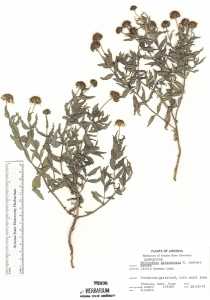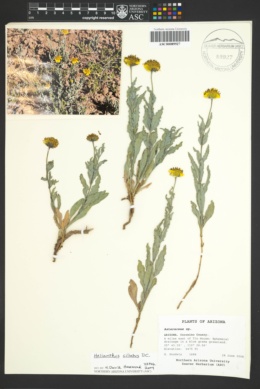|
|
 Plants ASU Vascular Plant Herbarium, Usage Rights: CC BY-NC (Attribution-Non-Commercial) | | | | | |
|
Origin:
Native
Life Cycle:
Perennial Similar Species: Helianthus ciliaris, H. laciniatus
General Desc:
Perennial with long creeping roots and smooth, bluish-green, erect, climbing stems. Leaves are lance-shaped, bluish-green and stalkless. Flowers have small yellow sunflower-like heads which grow singly or in rounded clusters of up to 7 at the branch tips.
Identification notes: Perennial with rhizomes, stems erect; leaves opposite, gradually smaller up the stem, bluish-green; phyllaries (bracts) narrow to lance-like, hairy; disc flowers (30+) and ray flowers (10 to 14) yellow; anther tips triangular.
Height:
To nearly 1 foot
Habitat Description: Dry, frequently sandy soil especially in open pine woodlands. This species is rare and poorly known from relatively few sites.
Plant Communities:
Pinyon Juniper Woodland, Montane Conifer Forest
Elevation: 4000 - 7000 feet
Color:
Yellow
Shape:
Daisy or dandelion-like in round clusters
Tubular:
N
Flowering Period:
Jun - Aug
Description:
There are 1 to 7 flower heads per branch. Each head has an outer rim of 10 to 14 strap-shaped yellow ray florets encircling a center of 30+ yellow tiny tube-like disc florets. Below the flower head are leaf-like bracts fringed with fine marginal hairs.
Leaf Color:
Bluish-green
Leaf Type:
Simple
Leaf Shape:
Narrow
Leaf Margin:
Smooth
Leaf Attachment:
Opposite
Leaves Clasp:
N
Hairs:
No
Spines:
N
Leaf Description:
Leaves are about 2 to 3 inches long and 1/2 inch wide with the leaf tip having a short, sharp point. The margins are generally smooth but may be wavy (undulate). The leaf surface is smooth (glabrous) and has a bluish-green color.
Fruit Type: Achene
Fruit Notes: Fruit is a type of achene called a cypsela. It is dry, flat, smooth, 1-seeded and about 1/8 inch long. It has 2 thin stiff bristles at its tip which detach easily aiding in fruit dispersal. The cypsela does not split open when mature to release the seed.
Seed Notes: The single seed nearly fills the inside of the fruit but does not adhere to it making it easier to separate from the fruit and disperse.
|
|

